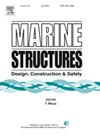基于模型的海上风力发电机支撑结构疲劳监测虚拟感知方法的长期验证:与现有基础模型的比较
IF 5.1
2区 工程技术
Q1 ENGINEERING, CIVIL
引用次数: 0
摘要
基于模型的虚拟传感为监测海上风力发电机的疲劳载荷提供了一种可行的方法。这些方法将响应测量与第一性原理或数据知情模型相结合,以估计难以进入位置的负载时间序列。然而,它们的精度取决于基础模型的保真度,这在很大程度上受到土-结构相互作用(SSI)模型不确定性的影响。本研究评估了不同SSI建模方法的影响,根据虚拟传感验证研究,针对底部海上风力涡轮机泥线上下的应变估计。为此,从设计文档中导出并验证的不同数值模型作为双频模态分解和展开(MDE)方法的输入。考虑的SSI模型范围从基于API/ dnv的基础模型到包含冲刷保护的基于pisa的模型。虚拟传感结果为两年等效数据集生成,这些数据集由三个运行中的海上风力涡轮机获得,每个涡轮机都配备了广泛的负载监测系统。一台涡轮机用于评估模型更新的效果,而另外两台涡轮机用于评估跨站点的一致性。根据损伤等效应力,直接将估计的应变与可用的应变验证数据进行比较,并将其累积为两年期间的单一比较度量代表。结果表明,基于pisa的土体反应曲线显著提高了与实测应变的一致性,而加入冲刷防护模型的影响相对较小。这些发现强调了在虚拟传感中精确的基础建模的重要性,并证明了在难以接近的位置进行疲劳监测的可行性。本文章由计算机程序翻译,如有差异,请以英文原文为准。
Long-term validation of a model-based virtual sensing method for fatigue monitoring of offshore wind turbine support structures: Comparing as-designed with state-of-the-art foundation models
Model-based virtual sensing offers a viable approach for monitoring fatigue loads on operational offshore wind turbines. These methods combine response measurements with first-principle, or data-informed models, to estimate load time series at hard-to-access locations. However, their accuracy depends on the fidelity of the underlying model, which is largely influenced by uncertainties in the soil–structure interaction (SSI) models.
This study evaluates the impact of different SSI modelling approaches in terms of a virtual sensing validation study targeting strain estimation above and below the mudline of a bottom-founded offshore wind turbine. To this end, different numerical models derived from, and validated against, design documentation serve as input to a dual-band modal decomposition and expansion (MDE) method. The considered SSI models range from an API/DNV-based foundation model to a PISA-based model including scour protection. Virtual sensing results are generated for two-year equivalent datasets, obtained for three operational offshore wind turbines, each equipped with extensive load monitoring systems. One turbine is used to assess the effect of the model updates, while two additional turbines are used to assess the across-site consistency. The estimated strains are directly compared against available strain validation data, in terms of damage-equivalent stress, and are accumulated to give a single comparative metric representative for the two-year periods.
Results show that PISA-based soil reaction curves significantly improve agreement with measured strains while adding a scour protection model has a relatively smaller impact. These findings highlight the importance of accurate foundation modelling in virtual sensing and demonstrate the feasibility of fatigue monitoring at hard-to-access locations.
求助全文
通过发布文献求助,成功后即可免费获取论文全文。
去求助
来源期刊

Marine Structures
工程技术-工程:海洋
CiteScore
8.70
自引率
7.70%
发文量
157
审稿时长
6.4 months
期刊介绍:
This journal aims to provide a medium for presentation and discussion of the latest developments in research, design, fabrication and in-service experience relating to marine structures, i.e., all structures of steel, concrete, light alloy or composite construction having an interface with the sea, including ships, fixed and mobile offshore platforms, submarine and submersibles, pipelines, subsea systems for shallow and deep ocean operations and coastal structures such as piers.
 求助内容:
求助内容: 应助结果提醒方式:
应助结果提醒方式:


